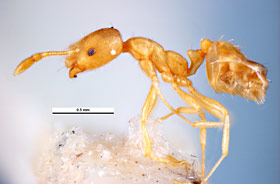Pharaoh Ant, Monomorium pharaonis

Pest and Diseases Image Library, Bugwood.org.
IPM Steps to Reduce Pharaoh Ants
1. Sample for Pest
Before taking any action, confirm the presence of more than one ant—it may have come in on clothing or packaging. Inspect the adjacent areas along walls (interior and exterior) now and again later. An ant or two may be searching for a food source—don’t let them find it! Develop a knowledge of where ants are likely entering and make a practice to inspect and anticipate.
Where to find it while inspecting: Pharaoh ants prefer warmth for their colonies and so have a fondness for establishing nests in buildings. Colonies contain many queens that often start new nests nearby.
2. Proper ID
To best treat a pest, you must be sure what it is.
Size and Particulars: 1/16" (1.5 to 2 mm) (queens 4 mm) , yellowish brown to pale brown in color.
3. Learn the Pest Biology
Ants follow scent trails to and from food sources. Pharaoh ants like both fatty and sweet foods.
Life Cycle: Males and females mate within the nest (males are dark and do not stay in the nest after mating). Queens are darker than workers, can raise large batches of eggs, including many daughter queens.
Preferred Food Sources: Especially interested and successful in finding human food as a food source—both fatty and sweet. Workers forage day and night.
Preferred Habitat: Inside buildings due to their preference for warmth, and therefore are often pests in large food-service areas.
4. Determine Threshold
If you’ve seen ant activity, you need to act. See “Choose Tactics”. Pharaoh ants have been known to vector food-borne diseases when they’ve infested a food preparation area.
Threshold: Any confirmed sighting of Pharaoh ants in a building is cause to act.
5. Choose Tactics
IPM for indoor pests is always a combination of exclusion and sanitation: Don’t provide access to water, food and shelter!
Best Management Practices: IPM to reduce numbers is prevention. Reduce any chance that Pharaoh Ants may find a food source inside your building. They have been known to build nests in debris such as newspaper, cardboard, and any place warm inside a wall. Baits are the preferred method of treatment of Pharaoh ant. Make sure you choose one that works for both “grease” and “sweet ants”. Allow the ants to take bait back to their nests. Inspect and monitor carefully as there are often multiple nests.
Treatment Methods: To avoid dispersing the colony into multiple new nests, NON-repellant baits should be used and placed on ant trails—this takes some time on your part. These baits generally contain boric acid, hydramethylnon or sulfonamide. In addition, IGRs (insect growth regulators) will prevent the production of new workers and sterilize the queens. This takes time to do in a large colony and every effort should be made to locate additional nests. NOTE: DO NOTE APPLY pesticides directly to nests. It will create more nests as survivors disperse!!
6. Evaluate
Was the tactic successful? Record the date pests were first noted, and the tactic you used, and its success. Use one of our RECORD KEEPING tools.
For More Information:
Remember:
When a pesticide application is necessary, all necessary and required precautions are taken to minimize risk to people and the environment and to minimize risk of pesticide resistance or pest resurgence. Pesticide use in your school may be prohibited or regulated by local policies or state and federal regulations. Risk reduction methods can include, but are not limited to, spot-treatment, the use of gel or paste bait formulations placed in inaccessible locations, injection into a crack or crevice, and other methods that reduce potential exposure.